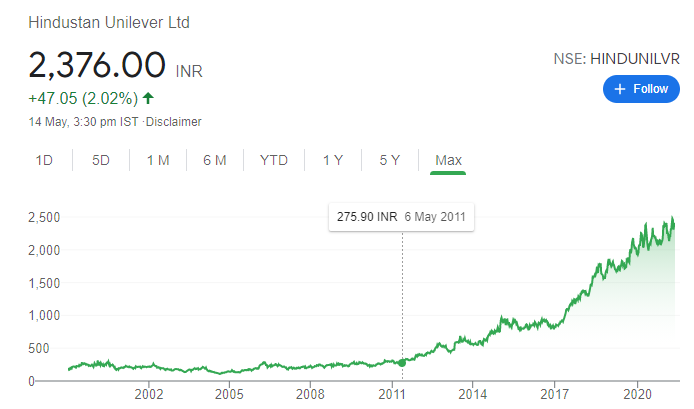HUL Company Analysis is an interesting one if you are studying India’s FMCG Sector. India’s USD 70 Bn FMCG market is the major contributor to India’s GDP. The household and personal care segment is the primary driver and accounts for 50% of India’s FMCG sales.
With 44+ brands across 14 distinct categories, HUL dominates the FMCG market in India. 90% of households in India use one or more HUL brands. It has also entered the top 15 global consumer staple stocks list with a current market cap of USD 75Bn. So, let us see some interesting facts in this HUL company analysis.
- Reach in 8 million+ outlets in India (i.e., 60% of India’s outlets).
- One of the largest distribution networks in India with 4,500+ distributors.
- #1 in 8 product categories (Skincare, skin cleansing, hair care, fabric wash, household care, tea, health drinks, ketchup).
- Leading fabric wash brand (surf excel) generates Rs. 5,000+ Cr. revenue. And with a market share of ~18%, it accounts for 14% of its revenue and 45% of its laundry segment sales.
- Three brands generate Rs. 2,000+ Cr. revenue.
- Eight brands generate Rs. 1,000+ Cr. revenue.
- Nine brands generate Rs. 500+ Cr. revenue
With that, let’s see how does HUL position itself as a brand
HUL markets itself as a multi-local multinational. It is the Indian subsidiary of Unilever PLC that holds ~62% of the share in the company and offers international expertise to the service of local consumers in the broad spectrum of product categories defined in its mission statement.
![]()
HUL offers its products according to the taste and preference of the local consumers as India is not a homogeneous market. It includes customers from various clusters based on their socio-economic attributes and it provides value to customers in terms of price and quality.
It has a robust competitive performance, with ~85% of its business is gaining penetration and >90% of business is winning a share of the market. Hence, Forbes ranked HUL as the most innovative company in India and 8th globally.
With this, it’s critical to understand HUL segments & revenues
HUL has classified its business into four broad divisions. Given below is the division wise revenue contribution.
- Home care ~35%
- Beauty & personal care (BPC) ~45%
- Food and refreshment ~19%
- Others ~1%

Total revenue for HUL in FY 2020 was Rs. 38,785 with YoY growth of ~3%. BPC segment is discretionary, and its demand is more affected by macro-economic factors; still, it continues to be a significant driver and generates ~45% of revenue for the company.
HUL continues to strengthen its market position in the BPC segment by driving penetration in core brands, such as Dove, Ponds, Sunsilk, and dominate the hair care and skincare category market.
***** AR10 – Annual Report Sprint – Details here ******
And what about division-specific growth?
If we look at the growth of these segments over the last 5 years, we can see that the Foods and refreshment segment and Homecare are growing at par. The foods and refreshment segment is expected to show signs of significant growth because of its recent acquisition of GlaxoSmithKline Consumer Healthcare (GSKCH).
Growth in other segments, including infant and feminine care, is declining significantly. HUL is trying to improve its market position in these segments by adding new products in this category after its recent acquisition from Glenmark Pharmaceutical.

Now the question is, will the recent merger improve growth prospects for HUL?
HUL acquired GSKCH for Rs. 31,700 crores and paid additional Rs 3,045 crores for developing its health and food drinks brand, Horlicks. HUL will leverage its distribution network and distribute GSKCH brands in India.
This will primarily expand the nutrition and health drinks business which remains underpenetrated in India as Horlicks is a #1 brand in the health and food drinks segment and have a volume share of 50%.
So, after the merger, revenue from the foods and refreshment segment is expected to reach Rs. 12,000 Crores in the current FY.
Moving on to profitability now…
HUL operates at a gross margin of ~70%, PBT of ~23%, and a net margin of 18%.
The beauty and personal care segment is the major contributor and accounts for 2/3rd of the profitability for HUL.


FMCG business operates on reasonably low margins, as you can see that net margins for HUL over the last five years is in the range of 12-17%. But the efficiency of the business depends on churn rate and inventory management.
The interesting thing to note over here is, they spend just over 12% on Advertising and Promotions.

So, how does HUL manage the working capital cycle?
Companies in the FMCG sector generally operates with a negative working capital because of efficient supply chain management. The industry has low debt and usually financed by creditors.

If you see HUL, then over the last few years, it operates with negative working capital. Let us see some ratios for FY 2020 and understand its working capital cycle.

So turnover ratios suggest how efficient a company is to manage its working capital, including inventory, debtors, and creditors.
HUL has a negative working capital cycle of 109 days. That means the company receives inventory on day one and sells it on day 24th. It accepts cash on day 37th (24+13). And no money leaves the company until day 146th when the suppliers are paid. This is beneficial for the business as money is not going out, and it provides funding to the industry for 109 days.
Thus, because of its brand loyalty, HUL can sell products and generate cash quickly before it has to pay the bills to its suppliers.
What’s in it for the shareholders?
HUL has a low capital intensity and has a marketing expense of ~12% of the revenue. It does not engage in a direct price war with its competitors; instead, try to outspend on marketing and advertisements. This creates a healthy, profitable scenario in the industry. And HUL profits have grown 2.5x over the last ten years. And the stock price almost 8 times 🙂
This has generated stellar returns for its stakeholders, where:
ROCE is consistent 100%+
ROE is consistent at 75%+

So HUL offers almost everything, whatever is expected from a perfect business. With its diverse product portfolio and robust distribution network, it has created a wider reach even in the interiors of the country and has positioned itself as a brand.

Other Trending Posts in this Series – DMart Valuation | PVR Cinema | Urban Company
To stay updated about all of our posts on Businesses and Finance Careers – register and create a free account on our website. You will also get access to a free Finance Bootcamp course once you register.










